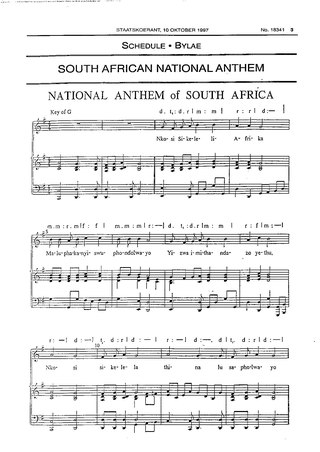
The national anthem of South Africa was adopted in 1997 and is a hybrid song combining extracts of the 19th century Xhosa hymn "Nkosi Sikelel' iAfrika" and the Afrikaans song that was used as the South African national anthem during the apartheid era, "Die Stem van Suid-Afrika", with new English lyrics.

György Sándor Ligeti was a Hungarian-Austrian composer of contemporary classical music. He has been described as "one of the most important avant-garde composers in the latter half of the twentieth century" and "one of the most innovative and influential among progressive figures of his time".
Joël-François Durand is a French composer.
Unsuk Chin is a South Korean composer of contemporary classical music, who is based in Berlin, Germany. Chin was a self-taught pianist from a young age and studied composition at Seoul National University as well as with György Ligeti at the Hochschule für Musik und Theater Hamburg.

Marion Eugénie Bauer was an American composer, teacher, writer, and music critic. She played an active role in shaping American musical identity in the early half of the twentieth century.

Tania León is a Cuban-born American composer of both large scale and chamber works. She is also renowned as a conductor, educator, and advisor to arts organizations.

Lukas Ligeti is an Austrian-American composer and percussionist. His work incorporates elements of jazz, contemporary classical and various world musics, especially African traditional and popular music styles.

Katherine Kennicott Davis was an American composer, pianist, arranger, and teacher, whose most well-known composition is the Christmas song "Carol of the Drum," later known as "The Little Drummer Boy".
Stefans Grové was a South African composer. Before his death the following assessment was made of him: "He is regarded by many as Africa's greatest living composer, possesses one of the most distinctive compositional voices of our time".
Isak Roux is a South African born German composer born in 1959. He is known for his arrangements of South African music, especially his work with the musical groups Ladysmith Black Mambazo and Kwela Tebza.

Else Marie Pade was a Danish composer of electronic music. She was educated as a pianist at the Kongelige Danske Musikkonservatorium in Copenhagen. She studied composition first with Vagn Holmboe, and later with Jan Maegaard, from whom she learned twelve-tone technique. In 1954, she became the first Danish composer of electronic and concrete music. She worked with Pierre Schaeffer and Karlheinz Stockhausen, as well as Pierre Boulez.
NewMusicSA is a non-profit arts advocacy organisation that promotes the creation, performance, and enjoyment of South African new music. Founded in 1999 and operating formally since 2003, NewMusicSA is the South African section of the International Society for Contemporary Music (ISCM).

Elsa Jacqueline Barraine was a composer of French music in the time after the neoclassicist movement of Les Six, Ravel, and Stravinsky. Despite being considered “one of the outstanding French composers of the mid-20th century,” Barraine's music is seldom performed today. She won the Prix de Rome in 1929 for La vierge guerrière, a sacred trilogy named for Joan of Arc, and was the fourth woman ever to receive that prestigious award.

Jeanne Behrend was an American pianist, music educator, musicologist and composer.

Anton Carlisle Hartman (1918–1982) was a South African conductor. He was head of music and principal conductor at the South African Broadcasting Corporation (SABC) and head of music at the University of the Witwatersrand. He became a central figure in art music in South Africa during the mid 20th century.
Adolph Hallis was a South African pianist, composer and teacher.
Clare Loveday is a South African contemporary classical music composer.
Peter James Leonard Klatzow was a South African composer and pianist.

Philip Miller is a South African composer and sound artist based in Cape Town. His work is multi-faceted, often developing from collaborative projects in theatre, film, video and sound installations.











